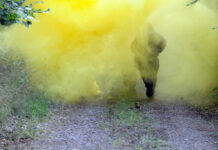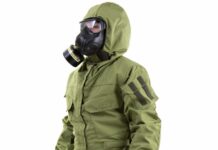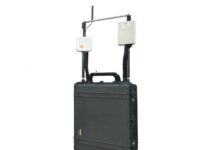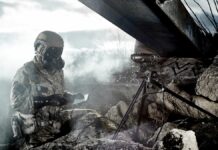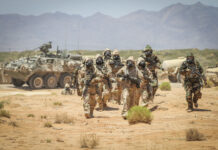The increasing budget of the Ministry of Defence of the Czech Republic in recent years has enabled the Czech Armed Forces to finally modernise some of its Chemical, Biological, Radiological and Nuclear (CBRN) reconnaissance vehicles and, most importantly, to purchase a new combat CBRN reconnaissance system consisting of S-LOV-CBRN and LOV-CBRN II vehicles.
Legacy Systems
The Czech chemical troops entered the new millennium with obsolete BRDM-2rch and UAZ-469CH radiological-chemical reconnaissance vehicles which were deployed to Kuwait and Iraq as part of the Czech participation in Operation Enduring Freedom in 2002 and 2003. Both vehicles retained their original Soviet and Czechoslovak detection systems, although the former was later equipped with new technology such as the RAID-1 chemical threat detector and the RDS-200 portable multipurpose radiation metre. Despite their considerable age, both types are still operated by the Army of the Czech Republic (Armáda České republiky, AČR).
The situation improved in the first decade of the 21st century with the introduction of new mobile systems based on the Land Rover DEFENDER 130 chassis with a box body superstructure and a trailer. The first of them was the Land Rover RCH designed by the Vojenský technický ústav ochrany (in 2013, reorganised into Vojenský výzkumný ústav – VVÚ) for mobile semi-automated radiological and chemical reconnaissance, delineation of the contaminated area, radiological, chemical and meteorological observations, as well as determination of nuclear explosion parameters. A prototype was produced in 2001 and subsequently deployed to Kuwait and Iraq as part of Operation Enduring Freedom. Only eight vehicles from serial production were ordered in 2003 and 2005 and later introduced into the inventory of the 31st Radiological, Chemical and Biological Defence Regiment in Liberec.
The second vehicle, also developed by the Vojenský technický ústav ochrany, was the BIOROVER B2 capable of mobile survey, detection and identification of biological agents, transportation of biohazardous samples in special packaging, laboratory activities and decontamination of persons in field conditions. Some eight vehicles were manufactured between 2001 and 2004, with most of them currently operated by the Military Medical Institute in Prague.
Land Rover RCHM
Although the Land Rover RCH proved its worth during deployments to the Middle East and in the protection of the Athens 2004 Summer Olympics, as time went on it became apparent that the vehicle was in need of at least a partial upgrade. The main disadvantage was that the vehicle’s information system was not compatible with the current automated command and control system of the AČR. Another significant drawback was that the vehicle was equipped with an unsupported model of the fast chemical ion mobility spectrometry detector (RAID-1).
Therefore, the main aim of the modernisation was to ensure connectivity and compatibility with the field command and control system of the Czech Army (IS VŘ PozS AČR) and improve the onboard chemical detection system. The modernisation project started in 2014. During the following year, a contract for the development and conversion of one Land Rover RCH was concluded with the state enterprise VVÚ. Upon its completion, the Land Rover RCHM prototype underwent a series of tests, including operational evaluation, which resulted in minor modifications to the vehicle and the writing of a definitive user manual. Subsequently, the prototype was introduced into the ORBAT of the 31st Radiological, Chemical and Biological Defence Regiment in 2017.
The Land Rover RCHM is designed to perform radiological, chemical and non-specific biological surveys and observations with automatic data collection, evaluation and information transfer. In an emergency, these tasks can also be performed in manual mode. The vehicle has a brand new communication and information system based on an all-in-one computer. Original communication equipment was replaced with the VICM 200 COMBAT intercom and the RF-13250E radiostation produced by MESIT.
The chemical detection system is based on the RAID-M100 chemical agent detector with an ammonia sensor. Other detection systems remained mostly without changes. Navigation capabilities were enhanced with the installation of the AN/PSN-13 Defense Advanced GPS Receiver (DAGR) and civilian Garmin ZUMO 590LM navigator. The AČR currently has no plans to upgrade the remaining RCHs, which will instead be replaced by the S-LOV-CBRN and LOV-CBRN II vehicles by 2023.
BIOROVER B2M
A similar modernisation effort was also carried out on selected BIOROVER B2 biological vehicles. The aim of the upgrade was to replace obsolete instrumentation for detection and identification of biological agents, computer technology, decontamination equipment, personnel protection gear and other special equipment installed in the superstructure and trailer. The contract for the upgrade of two BIOROVER B2 vehicles and four BIOROVER 110 vehicles (rudimentary variant based on the regular Land Rover DEFENDER 110 SW with a trailer) was signed with state-owned company Vojenský technický ústav on 22 May 2020. The modernised vehicles were handed over to the AČR representatives by the end of the same year.
The upgraded BIOROVER B2M (also designed as the BIOROVER 130-M) is used to conduct biological reconnaissance, collect samples, detect and identify biological agents in field conditions and safely package and transport biological samples in special containers. The BIOROVER B2M has clean and wastewater tanks in the trailer for the decontamination shower, an inflatable tent and a sampling kit. The vehicle body is equipped with a biological isolator and other equipment for the safe processing and preparation of samples for laboratory analysis by molecular genetic methods directly in the field.
Within the frame of the modernisation, the box-body superstructure was equipped with a next-generation sequencing system based on the iSeq 100 device and the MinION analyser for small molecule DNA analysis. The obsolete R.A.P.I.D. instrument for rapid identification of dangerous biological agents was replaced by the MIC qPCR cycler. The original BK-56 communication and information block, as well as two old laptops, were replaced by new portable workstations. Another change is the use of the DC100 decontamination shower instead of the original EDK-04 type.
S-LOV-CBRN and LOV-CBRN II
The recent acquisition of the S-LOV-CBRN and the LOV-CBRN II armoured chemical, biological, radiological and nuclear reconnaissance vehicles is undoubtedly the most important rearmament project for the Czech chemical troops in recent years.
The development of the S-LOV-CBRN and the production of one prototype took place between 2009 and 2012 and cost the Ministry of Defence CZK 98M (EUR 3.9M). The first S-LOV-CBRN was officially introduced into the ORBAT of the AČR (311th Radiological, Chemical and Biological Defence Battalion at Liberec) in 2014. However, due to a lack of funds, the purchase of production vehicles had to be postponed. Therefore, the Ministry of Defence concluded the related contract with VVÚ for the delivery of 40 S-LOV-CBRNs and 40 LOV-CBRN IIs on 30 August 2018. The value of the deal was CZK 5,111Bn (EUR 199M). Due to the acquisition delay, some of the equipment used originally in the prototype had to be replaced with new technology.
The S-LOV-CBRN and LOV-CBRN II are designed for conducting CBRN reconnaissance and observation, including sampling and transport of samples, through automated superstructure with integrated CBRN detection systems. The crew of each vehicle comprises two soldiers.
The S-LOV-CBRN consists of the LOV-CBRN reconnaissance vehicle and the P-LOV-CBRN off-road trailer. The LOV-CBRN is based on the Iveco M65E19WM LMV light armoured vehicle. It is equipped with detection instruments for CBRN reconnaissance and situation monitoring with the automated operation, integrated chemical agent detection subsystem, radiation monitoring subsystem and biological aerosol detector. The vehicle is capable of automatic collection and processing of CBRN information from on-board equipment for monitoring of chemical (such as GID-3, RAID-M100, AP2C, CHP-5), radioactive (DPV-1, RDS-200) and biological contamination (SmartBio Sensor). There is a demarcation device on the starboard side of the superstructure with the control unit and heads for delineation of the contaminated area by signal flags. The onboard IRDAM 5056B meteorological station enables the measurement of basic meteorological parameters of the ground layer of the atmosphere without the need for the crew to leave the vehicle.
The cab has ballistic protection of Level 3 and mine protection of Level 2a according to STANAG 4569. The superstructure is not ballistically protected as a whole, and only its key elements are armoured. Protection of the crew against the effects of chemical and biological agents, as well as radioactive dust, is provided by a combined overpressure protection subsystem enabling operation in the vehicle without wearing protective masks. Also incorporated is a system of emergency clean air supply in case of internal contamination of the crew cabin.
For self-defence, the LOV-CBRN is equipped with the ZSRD 07 remote controlled weapon station mounted on the superstructure. The weapon station is manufactured by Vojenský technický ústav and is fitted with the FN MAG machine gun, as well as the CRANE-SR1G sensor sight unit produced by EVPÚ Defence. Day vision is provided by a combination of a fixed-focus day camera and a zoom camera with colour and black-and-white mode. An uncooled thermal camera provides vision at night and in conditions of restricted visibility. Range measurements are performed by an eye-safe laser range finder. The vehicle carries a total of 2,000 rounds of 7.62 mm ammunition. The communication equipment is comprised of the AN/PRC-152A V4C and the AN/PRC-117G(V)1 radiostations. The integrated communication and information technology ensure full connectivity and compatibility with the IS VŘ PozS AČR command and control system.
The unmanned subsystem is composed of the ORPHEUS-AC2 Unmanned Ground Vehicle (UGV) which is carried in the rear part of the LOV-CBRN. The ORPHEUS- AC2 is designed for remote CBRN, visual and acoustic reconnaissance. It carries a beta probe, a gamma-ray detector, an automatic chemical detector, an oxygen sensor and a sampling device for atmospheric sampling. The UGV is also equipped with three cameras, a thermal imaging camera, a GPS unit and a system for acoustic monitoring.
The P-LOV-CBRN trailer on the PRAGA 35 (CL ARM 35 LMV) chassis carries the AMZ-CRN portable autonomous monitoring module, a portable weather station, a portable demarcation device and supporting equipment. The trailer provides electric energy to the vehicle at the static observation post through an internal power generating set or by connecting to a 230 V public electricity distribution network. Both LOV-CBRN and P-LOV-CBRN are fitted with the multispectral camouflage system made by B.O.I.S. – FILTRY for camouflaging in the visible, infrared (near, medium, far), and microwave spectra.
The LOV-CBRN II vehicle complements the capabilities of the S-LOV-CBRN and is directly based on the LOV-CBRN. Its equipment enables mobile and on-foot CBRN reconnaissance via a combined detection subsystem with automated operation and message transmission to the vehicle’s information system. The LOV-CBRN II carries a decontamination set and a kit for collection, short-term storage and transport of liquid and solid samples containing radioactive substances or military chemical and biological agents. The vehicle allows the integration of the STAR LIGHT SFP radio controlled improvised explosive devices jammer (within the parameters of the contract, only ten jammers were ordered).
The S-LOV-CBRN and the LOV-CBRN II are due to replace all BRDM-2rch, UAZ-469CH and Land Rover RCH vehicles within the ranks of the regular AČR units. The 311th and 312th Radiological, Chemical and Biological Defence Battalion of the 31st Radiological, Chemical and Biological Defence Regiment will become the primary users. The remaining S-LOV-CBRNs and LOV-CBRN IIs will be operated by the radiological and chemical reconnaissance squads of the combat battalions within the 4th Rapid Deployment Brigade and the 7th Mechanised Brigade, as well as some other combat support units.
The first 13 production vehicles of each type were delivered during 2021. The original schedule envisaged that shipments would be completed during 2022. However, due to the COVID-19 pandemic, this date has had to be postponed, so that the last vehicle is currently expected to be delivered by the end of July 2023.




